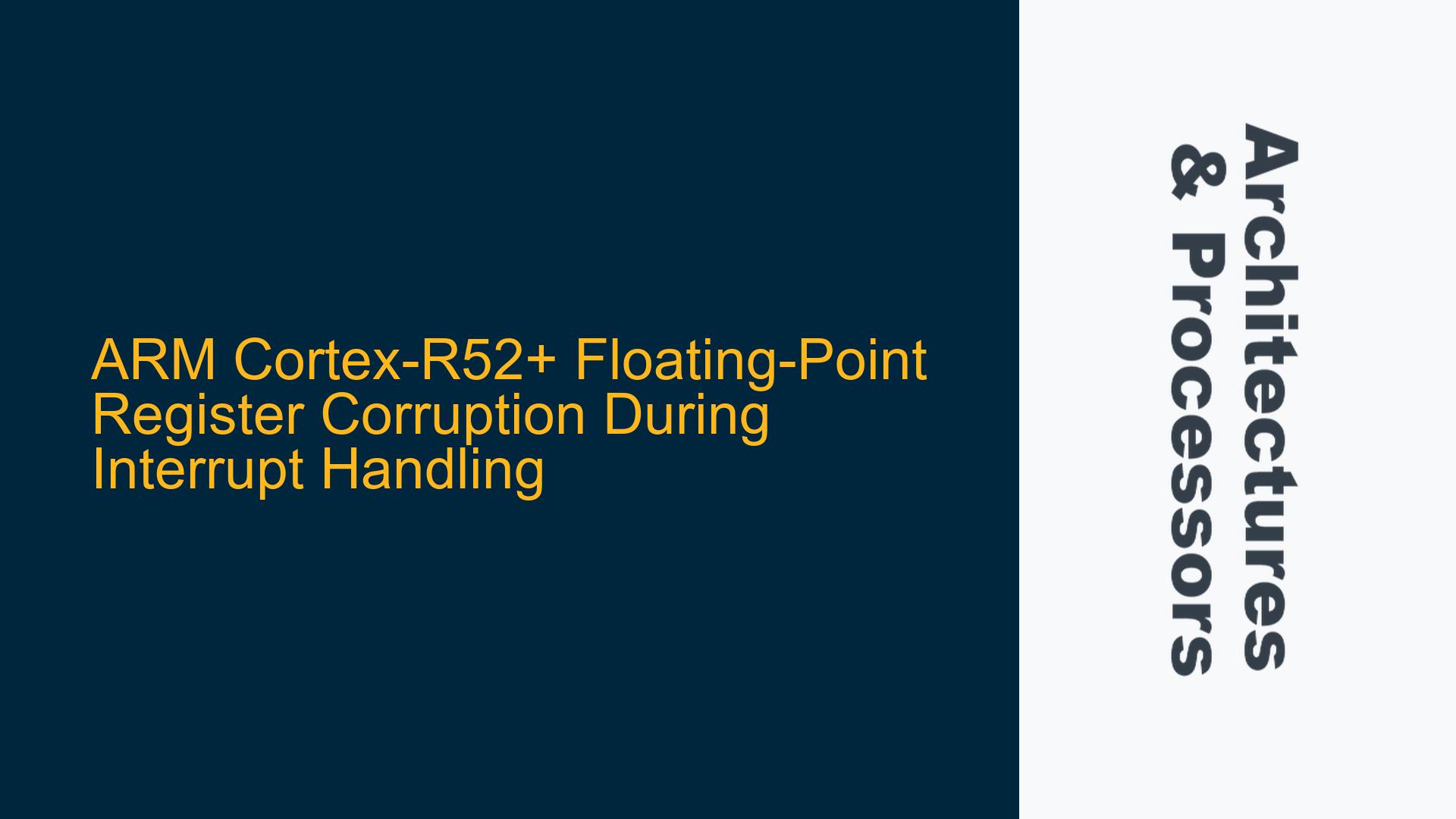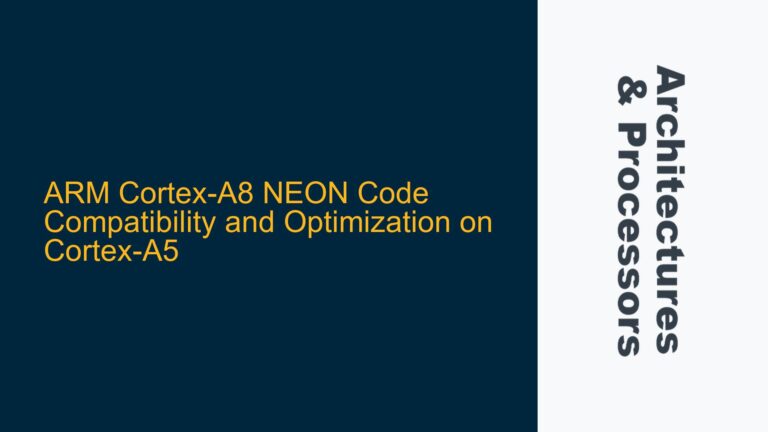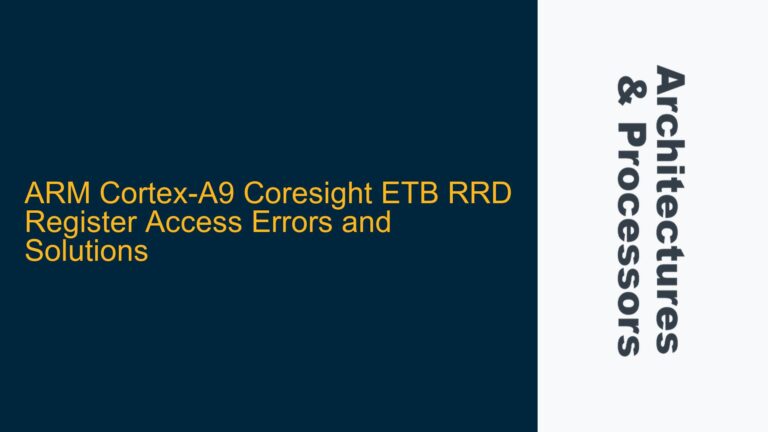ARM Cortex-R52+ Floating-Point Register Corruption During Interrupt Handling
The ARM Cortex-R52+ is a high-performance real-time processor designed for safety-critical applications. One of its key features is the support for floating-point operations, which are essential for tasks requiring precision calculations. However, in certain scenarios, particularly when dealing with interrupts and context switching, floating-point register corruption can occur. This issue manifests when the floating-point registers are not properly saved and restored during interrupt service routines (ISRs), leading to incorrect calculations and unexpected behavior in the main task.
In the described scenario, a floating-point variable test is initialized to 123.3f. During execution, the condition if(test < 123.0f) evaluates to true, even though the value of test should logically prevent this. Upon investigation, it was discovered that the floating-point register S15 contained a legacy value from a previous floating-point operation, suggesting that the vldr instruction failed to load the correct value from memory into the register. This issue was traced back to the ISR, which performed floating-point calculations without saving and restoring the floating-point registers, leading to corruption of the floating-point context in the main task.
The problem was temporarily resolved by adding VPUSH {D0-D15} and VPOP {D0-D15} instructions at the beginning and end of the ISR, respectively. However, questions remain about whether this solution is sufficient, particularly regarding the need to save and restore the Floating-Point Status and Control Register (FPSCR) and whether memory barrier instructions are required to ensure proper synchronization.
Floating-Point Context Corruption Due to Unprotected ISR Floating-Point Operations
The core issue stems from the corruption of the floating-point context during interrupt handling. The ARM Cortex-R52+ uses a set of floating-point registers (S0-S31, which can also be accessed as double-word registers D0-D15) for floating-point operations. These registers are part of the processor’s state and must be preserved across context switches, including those caused by interrupts. When an ISR performs floating-point operations without saving and restoring the floating-point registers, it can overwrite the values in these registers, leading to incorrect results when the main task resumes execution.
In the described scenario, the ISR performs floating-point calculations without saving the floating-point registers. When the ISR interrupts the main task, it uses the same set of floating-point registers, overwriting their contents. Upon returning from the ISR, the main task continues execution with corrupted floating-point registers, leading to incorrect calculations and unexpected behavior. This is particularly problematic in real-time systems, where timing constraints and the need for deterministic behavior make such issues difficult to diagnose and resolve.
The vldr instruction, which is used to load a floating-point value from memory into a floating-point register, may fail to load the correct value if the register has been corrupted by the ISR. This explains why the condition if(test < 123.0f) evaluates to true even though the value of test should prevent this. The legacy value in S15 is a result of the ISR overwriting the register with a value from a previous floating-point operation.
Ensuring Proper Floating-Point Context Preservation with VPUSH/VPOP and FPSCR Management
To resolve the issue of floating-point register corruption during interrupt handling, it is essential to ensure that the floating-point context is properly saved and restored. The VPUSH {D0-D15} and VPOP {D0-D15} instructions are used to save and restore the floating-point registers, respectively. These instructions push the contents of the specified floating-point registers onto the stack at the beginning of the ISR and pop them back into the registers at the end of the ISR, ensuring that the main task’s floating-point context is preserved.
However, saving and restoring the floating-point registers alone may not be sufficient. The Floating-Point Status and Control Register (FPSCR) contains status flags and control bits that affect floating-point operations. If the ISR modifies the FPSCR, these changes must also be saved and restored to ensure correct behavior in the main task. The VMRS and VMSR instructions can be used to transfer the contents of the FPSCR to and from a general-purpose register, which can then be saved and restored using standard stack operations.
In addition to saving and restoring the floating-point context, it may be necessary to use memory barrier instructions to ensure proper synchronization between the main task and the ISR. Memory barriers prevent reordering of memory operations, ensuring that all previous memory accesses are completed before subsequent instructions are executed. In the context of floating-point operations, memory barriers can be used to ensure that the results of floating-point calculations are correctly written to memory before the ISR returns control to the main task.
The following steps outline a comprehensive approach to resolving the issue:
-
Save and Restore Floating-Point Registers: Use
VPUSH {D0-D15}at the beginning of the ISR to save the floating-point registers andVPOP {D0-D15}at the end of the ISR to restore them. This ensures that the main task’s floating-point context is preserved across the ISR. -
Save and Restore the FPSCR: Use
VMRSto transfer the contents of the FPSCR to a general-purpose register at the beginning of the ISR andVMSRto transfer the contents back to the FPSCR at the end of the ISR. Save and restore the general-purpose register using standard stack operations. -
Use Memory Barriers: Insert memory barrier instructions (e.g.,
DSBandISB) as needed to ensure proper synchronization between the main task and the ISR. This prevents reordering of memory operations and ensures that the results of floating-point calculations are correctly written to memory before the ISR returns control to the main task. -
Verify Correctness: After implementing the above steps, thoroughly test the system to ensure that the issue is resolved. Pay particular attention to the behavior of floating-point operations in both the main task and the ISR, and verify that the floating-point context is correctly preserved across interrupts.
By following these steps, you can ensure that the floating-point context is properly preserved during interrupt handling, preventing register corruption and ensuring correct behavior in the main task. This approach is particularly important in real-time systems, where the integrity of the floating-point context is critical to the correct operation of the system.






